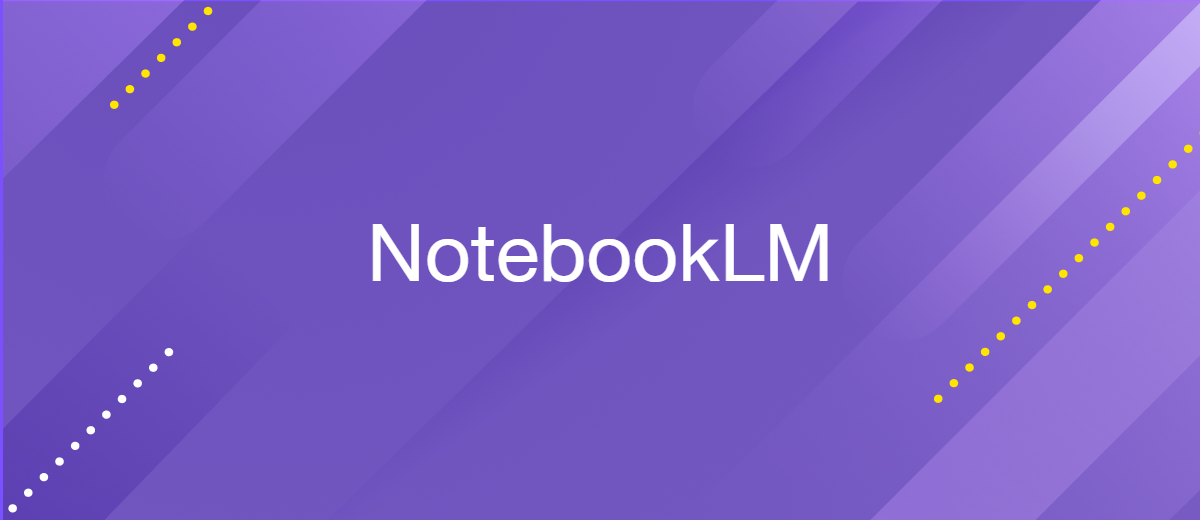NotebookLM and the Future of AI Knowledge Management
The rapid development of AI technologies is having a dramatic impact on how we work with information. AI assistants capable of automating data analysis and simplifying its systematization are becoming especially in demand in science, education, and business. One of the most notable solutions in this area as of 2025 is NotebookLM. Our article is dedicated to this very product. In the NotebookLM guide, we will examine its key features and capabilities, explore its use cases, and demonstrate how to use this tool to improve work efficiency.
What is NotebookLM
NotebookLM is an online service from Google Labs that automates data processing and analysis using AI algorithms. It works effectively with various content formats, including Google Docs, Google Slides, PDFs, copied text, web pages, images, video, and audio.
Google Gemini 2.0, integrated into the platform, quickly analyzes large documents and other materials. LLM can answer questions about their content and generate comprehensive summaries, guides, and podcasts. It can identify connections between multiple topics and create new content based on source files.
The project was first presented in 2023. Initially, it had experimental status. In December 2024, the developers released a paid version, NotebookLM Plus. Google One AI Premium subscribers were the first to receive access. Businesses can also use this tool through Google Cloud and Google Workspace.
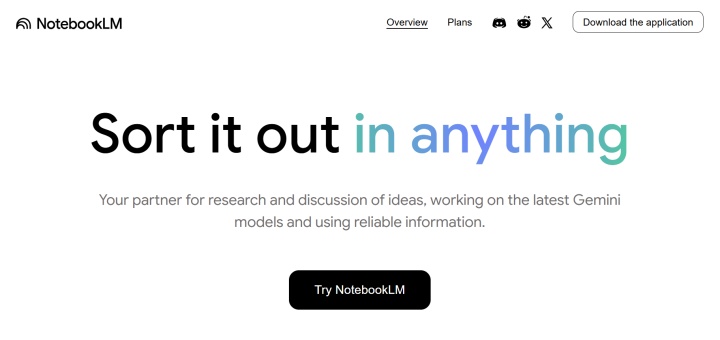
To get started with the AI research assistant, visit the platform's official website—notebooklm.google. Alternatively, download the app to your mobile device. Versions for iOS and Android are available on their respective app stores.
The free version of the program supports all basic features with a limited number of queries. It allows up to 50 chat queries, 3 audio summaries, and 3 video summaries per day, with a maximum of 100 notebooks, 50 sources per notebook, and up to 500,000 words per source.
The paid version of NotebookLM Pro provides 500 chat requests, 20 audio and 20 video summaries per day, up to 500 notebooks, and 300 source files per notebook. It features advanced chat settings, notebook analytics, and access control. You can upgrade to Pro by purchasing a Google AI Pro, Google AI Ultra, or Google Cloud subscription, or by choosing a suitable Google Workspace plan.
- Automate the work of an online store or landing
- Empower through integration
- Don't spend money on programmers and integrators
- Save time by automating routine tasks
Key Features of NotebookLM
The wide range of NotebookLM's features makes it a versatile tool for working with text and files. The platform helps you take notes and generate summaries, answer document questions, and create ideas. It can also structure and format information, as well as convert materials into podcasts.
Notes
The service allows you to create and manage personal annotations. To achieve this, use the Add note button. It's located in the lower right corner of the interface, under the Studio block.
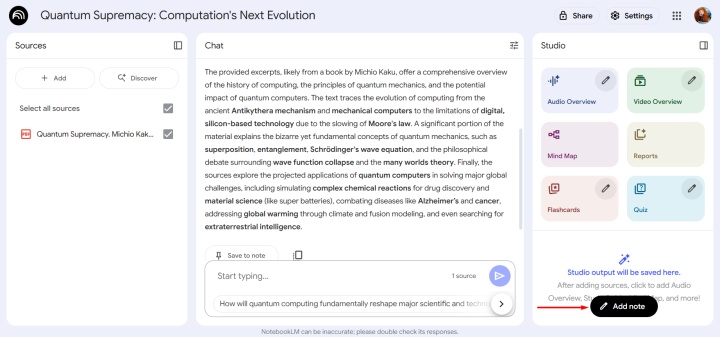
Users can thus save their own ideas, thoughts, and comments regarding a document or book. Notes can also be used to record important points and reports prepared by the service. Furthermore, it's a convenient way to collect AI responses received in NotebookLM chat, as well as store personal remarks, drafts, and lists of topics or questions.
User notes are stored in the same notebook as the document they're associated with. This arrangement makes them easier to access and speeds up the overall workflow.
Summary
With NotebookLM, you can get a summary of downloaded materials. To do this, simply add a document to Sources (the block on the left side of the interface) and send a request in the Chat window. For example, "Give a summary of this document" or "What is this book about?"
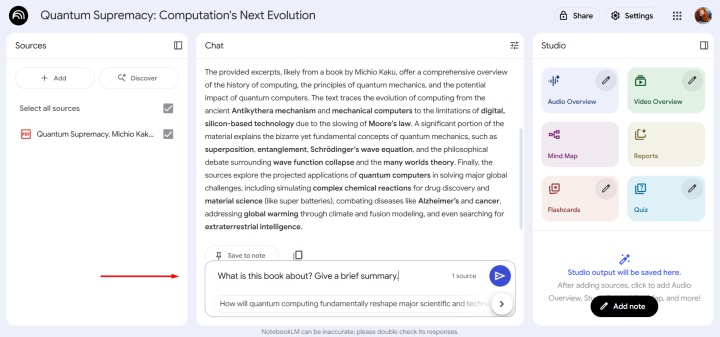
Using the Reports tool, you'll get a more detailed, structured summary of a source. It's suitable for writing notes, research papers, analyzing literary works, conducting comparative analyses of multiple sources, and creating data summaries from large texts. Working with such a document is much more convenient than reacting to a chat response.
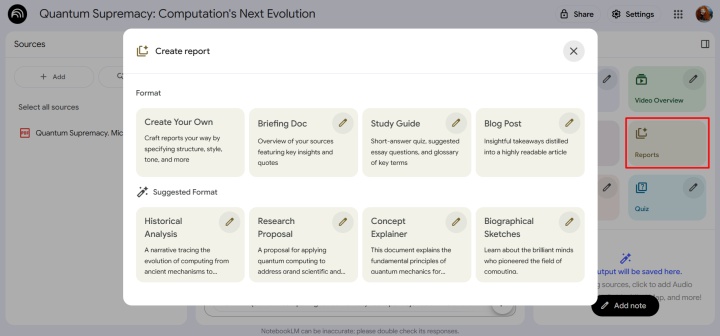
The system can prepare a report in 4 standard formats (Create Your Own, Briefing Doc, Study Guide, and Blog Post) and four variable formats (e.g., Research Proposal, Concept Explainer). The service selects the second four formats based on the document for which the report is being created.
Question and Answer
Primary interaction with NotebookLM takes place in the Chat window. Here, you can ask the AI any questions about the content of sources and receive answers supported by citations. To assist users, the service offers Suggested questions. These are very helpful if you're having trouble formulating your question.
How to ask a question:
- Select one of the suggested options in the Suggested questions block.
- Enter your question manually in the input field at the bottom of the screen and click the send button.
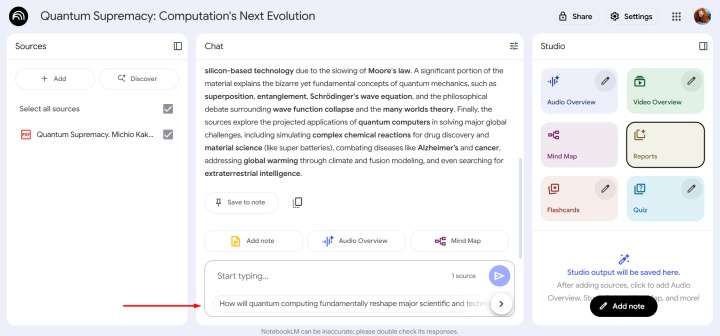
The received response can be saved in notes. If you store your notes elsewhere, you can copy the response by clicking the Copy button and pasting it into your work file. This copying feature is convenient if you need to quickly forward the AI response to someone via messenger apps.
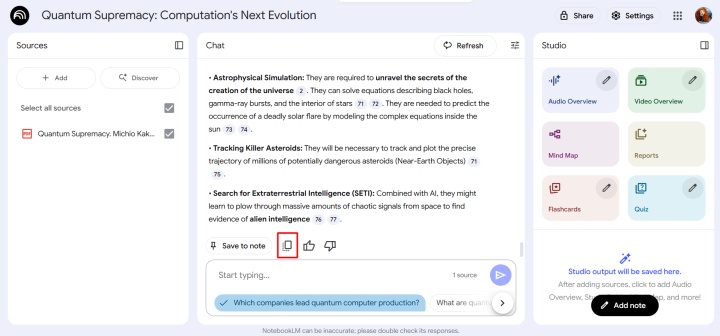
Ideas
One of NotebookLM's most sought-after features is idea generation. It's helpful when you need a fresh perspective, a new approach or innovative solution, a content plan, or a brainstorming session.
Directions for use:
- Generating new ideas based on a source. Upload existing materials to Sources. In the chat, ask, “Suggest 10 blog post ideas based on the content of the document” or “Review these materials and suggest 5 standard and 5 non-standard product applications in the beauty industry.”
- Update and refine existing ideas. Describe your idea in the chat, then ask NotebookLM to refine it or show alternative interpretations.
- Brainstorming without sources. The service can generate proposals on demand, without accessing sources. For example, ask it to suggest creative ideas for promoting a product to IT professionals.
- Evaluation and selection of the best ideas. At your request, NotebookLM can compare all submitted suggestions and select the most successful ones. You can set various selection criteria: effectiveness, feasibility, profitability, and so on.
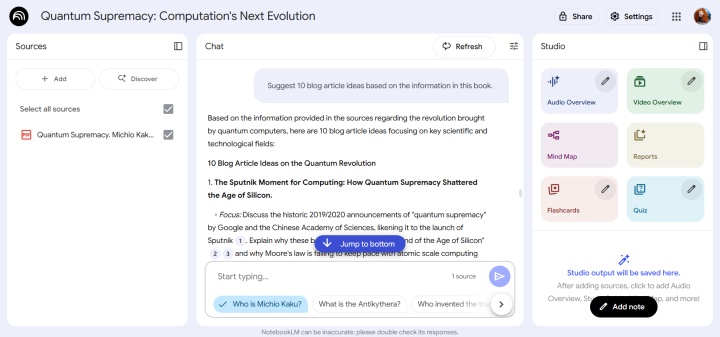
Bringing Text to Life: Video and Audio
NotebookLM has the ability to convert text loaded into video and audio. This is essential for those who perceive visual information more easily and effectively, as well as speech.
The Video Overview tool generates videos based on text documents or user notes. Before generating, you can select the language in which the video will be voiced. You can also tell the AI exactly what you'd like to see and which areas it should pay special attention to. This approach can be used to visualize ideas, create presentations and training materials.
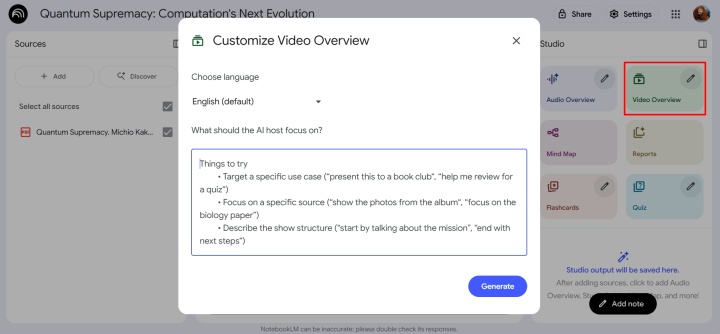
Audio Overview works on the same principle. The only difference is that it converts text into an audio file.
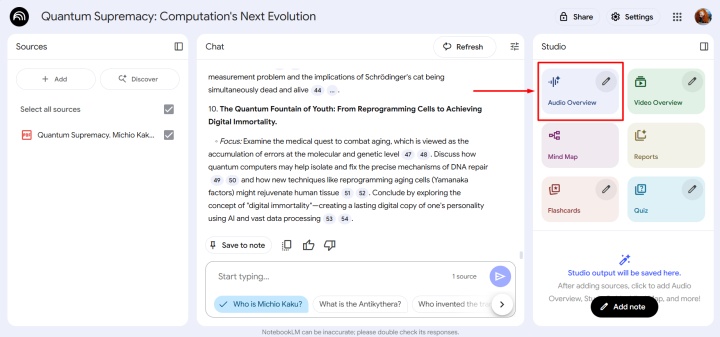
Before starting audio generation, NotebookLM prompts users to select a format (Deep Dive, Brief, Critique, Debate), language, recording length, and focus areas.
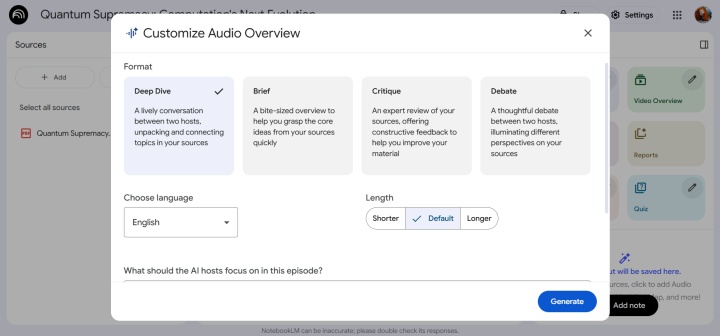
Using Audio Overview, you can, for example, listen to a report without having to read it. A student who hasn't had time to read a long summary can quickly convert the text to audio and listen before class. If reading is difficult due to vision problems, this feature is invaluable.
Generated videos and audio are not only available within NotebookLM. They can be downloaded to your device and shared via a link.
Visualization
The Mind Map tool visualizes uploaded text or user notes as a mind map. Presenting text in this format effectively structures the material and helps clearly and vividly identify interconnections. The tool is recommended when you need not just to skim a large amount of information but to thoroughly understand it within a short timeframe. This approach is also useful when preparing for a complex project or when discovering new concepts during brainstorming sessions.
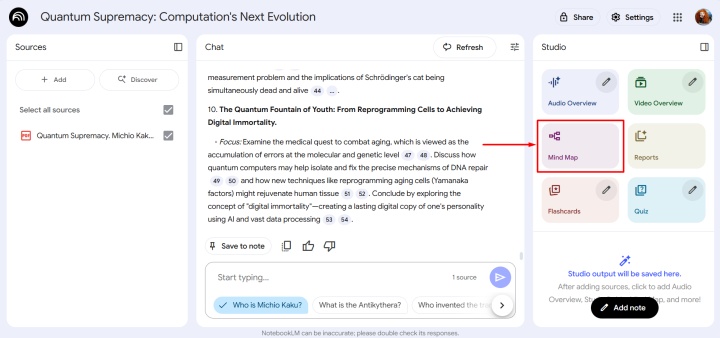
A mind map is created automatically. Simply select text or notes and click Mind Map. The generated map consists of a central theme and branches reflecting key points. By clicking on the branches, you can trace and explore the relationships between them.
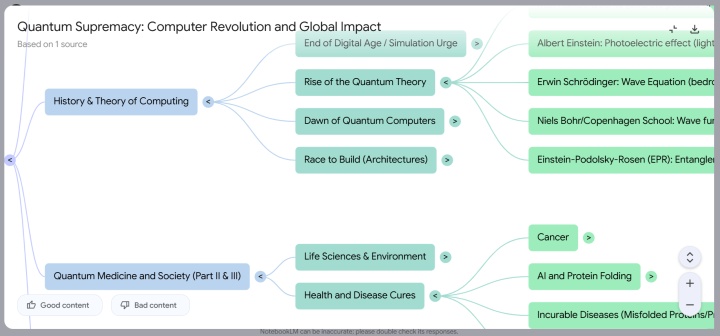
Help with Learning
Flashcards and Quiz tools help reinforce the knowledge gained after studying a text through active review and self-testing. They can be used during study, exam preparation, and training sessions in virtually any field. If you've just read a complex text and want to make sure you've understood it correctly, these tools are helpful. They also help ensure you retain everything you needed to know.
The primary purpose of Flashcards is to help memorize important information (concepts, dates, formulas, terms). This tool helps schoolchildren and students prepare effectively for exams and learn new topics and subjects. However, the use of flashcards is not limited to education. They are also valuable for work that requires retaining large amounts of information and quickly accessing answers without searching through a database. Examples include call centers and hotlines.
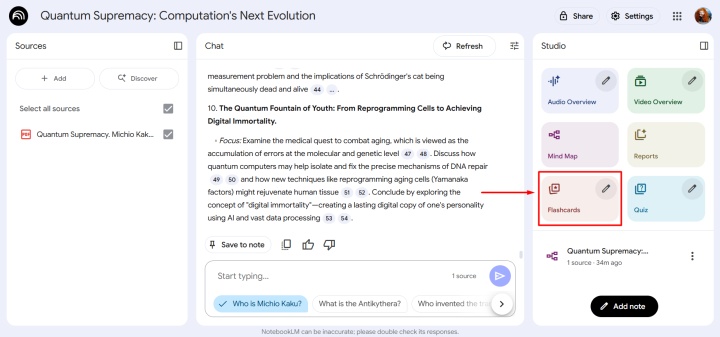
To use Flashcards, simply upload a text document to Sources and click on the tool's name. In the settings, select the desired number of cards, the difficulty level, and specify what the AI should focus on. After clicking the Generate button, the service will automatically create flashcards with questions. Each card will display a question on the front and the correct answer on the back.
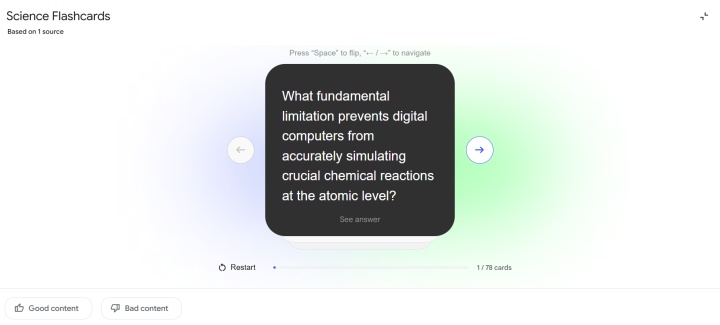
The main purpose of Quiz is to self-assess your understanding of reading material. The tool is used to ensure that you've fully grasped the text you've studied. It's a great resource before an exam, seminar, or important work meeting. Tests and quizzes are created in NotebookLM using uploaded documents or user notes.
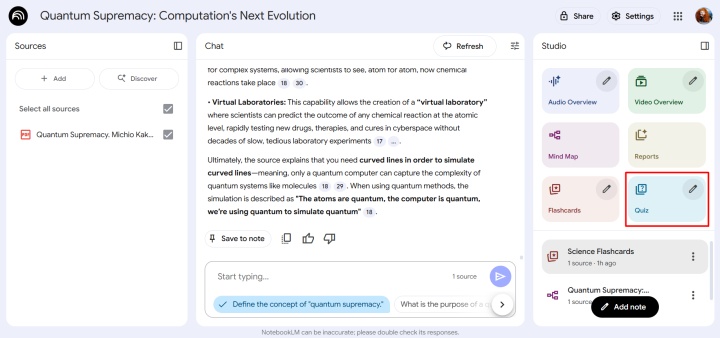
To create quizzes, select an uploaded document or notes and click Quiz. In the settings, select the number of questions and difficulty level, as well as what you want the AI to focus on. After clicking Generate, the service will generate a set of questions with multiple-choice answers.
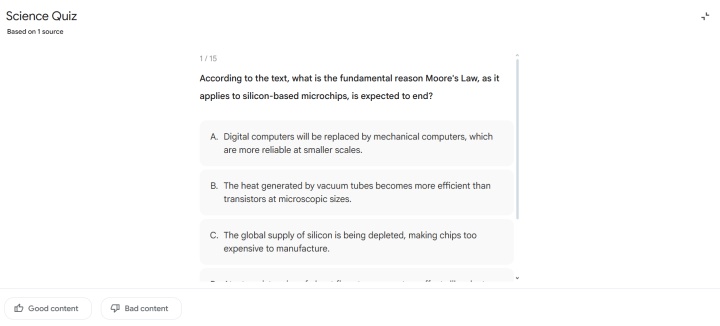
Opportunities for Students, Researchers, and Professionals
NotebookLM has long established itself as one of the most sought-after AI assistants for processing and analyzing information. The combination of broad functionality and versatility makes it a powerful AI for research and learning. Let's explore the opportunities this service offers for different categories of users.
Students
NotebookLM for students is a useful online assistant that can dramatically simplify and speed up various learning tasks. It allows students to quickly and easily create clear summaries from multi-page articles or hours of lecture recordings.
The service is always ready to answer any questions on the topic and explain complex concepts in simple terms. If needed, it can create a curriculum for any subject.
Researchers
NotebookLM is indispensable for research in various fields. Researchers simply upload any material to it to receive personalized insights with key points and concise conclusions. These insights can be used when preparing reports, presentations, articles, and research papers.
Professionals and Business
NotebookLM demonstrates excellent results not only in science and education. It is also ideal for solving problems for professionals and businesses in general. Its AI algorithms efficiently generate ideas for brainstorming sessions, identify trends and patterns, and conduct market and competitor research. They also carefully structure and format documents.
How to Use NotebookLM
NotebookLM is more than just a convenient online assistant. It's a full-fledged AI knowledge management tool that analyzes, structures, and organizes large amounts of information.
Step-by-step algorithm for working with the service:
1. Go to the platform's official website or download the mobile app (iOS/Android).
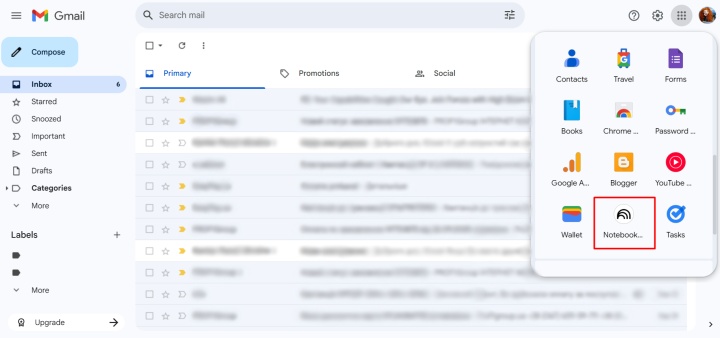
2. Log in with your Google profile and click Create new to add your first document.
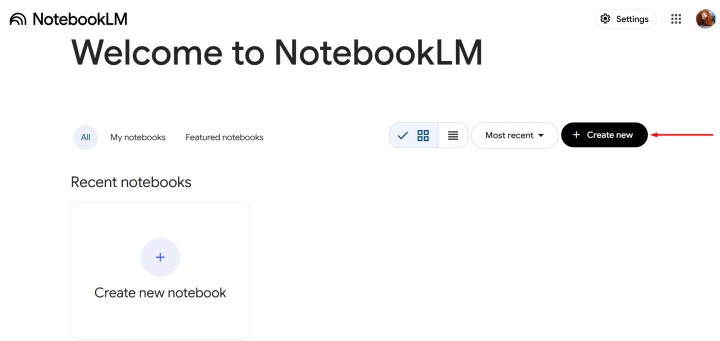
3. Choose the method that is most convenient for you to add a file: pasting copied text, uploading a TXT/PDF/Markdown document, entering a link to Google Docs/Google Slides/YouTube/any website, or the Discover option (AI search for relevant content sources on the Internet).
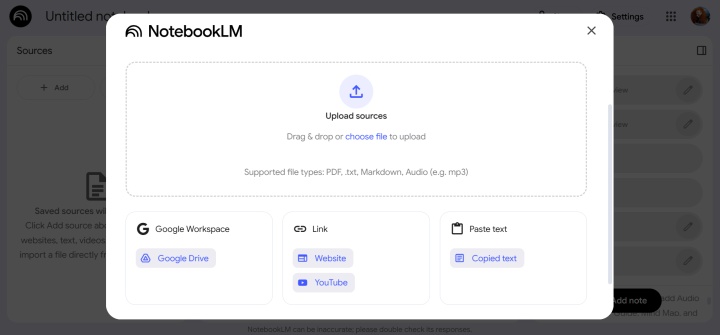
4. Select the mode for working with the uploaded document: Notes (create and manage notes and quotes), Chat (generate ideas, summaries, questions, and answers), Reports, Video Overview, Audio Overview, Mind Map, Flashcards or Quiz.
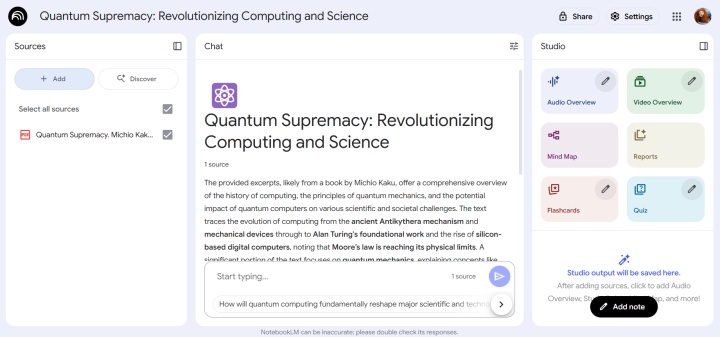
Limitations and Development Prospects
Google NotebookLM has not only advantages but also a number of limitations. The latter may make it inaccessible or inconvenient for some users.
Main barriers:
- File and request limits. Users of the free version of the AI note-taking tool can send up to 50 chat requests per day and generate up to 3 audio and 3 video summaries daily. The upload limit per file is 200 MB or 500,000 words. Paid subscribers (NotebookLM Plus) receive extended limits, including 500 chat queries and 20 audio/video summaries per day, up to 500 notebooks, and 300 sources per notebook.
- Limited language support. The browser version of the platform supports 80 languages, but the mobile app interface is only available in 39 languages. Furthermore, customer support is only available in English.
- Age and region restrictions. NotebookLM accounts must be for people 13 years of age or older. Moreover, the service is not available in all countries, only in those where the Gemini AI assistant is available.
- Response accuracy. Sometimes AI responses may be insufficiently accurate due to vague queries or a lack of relevant information in the sources.
To conclude our NotebookLM review, it is worth noting that the platform deservedly ranks among the best Google AI productivity tools. Its introduction has revolutionized the way we work with information. Now, summarizing and structuring information can be fully automated, and personalized insights generated by AI can be obtained.
Although NotebookLM is already being hailed as a game-changer in research and data analysis, its potential could grow significantly in the future. Expanded integration capabilities with third-party systems and increased file size and quantity limits will transform it into a powerful analytical platform. As a result, it will be in high demand not only among students and researchers but also in businesses across various industries.
All screenshots of the NotebookLM interface (source: notebooklm.google) are for informational purposes only. The interface and functionality of the service may be changed by the developer.
We remind you that with the help of our online connector ApiX-Drive you can implement automation yourself, without programming or special skills. Check out the step-by-step instructions for setting up integrations:
